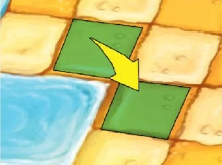Once the players have placed all their kangaroos on the board, the actual game
begins with the first player who placed one of his kangaroos.
In turn, each player moves one of their kangaroos.
For this, there are two options:
Either: The kangaroo WALKS onto an adjacent unoccupied space
(vertically, horizontally or diagonally - like a chess king). This
ends the player's turn.
Or: The kangaroo JUMPS (vertically, horizontally or diagonally)
over another kangaroo of any colour.
To do this, the other kangaroo must stand in the same line (vertically,
horizontally or diagonally) as the jumping kangaroo. The jumping kangaroo
must be able to land at the same distance beyond the other kangaroo
as from his starting place to that kangaroo (see illustration).
Note: the longest possible single jump is 14 spaces.
In addition, the following rules apply: The
kangaroo may not
- jump over more than one kangaroo
- land on another kangaroo; the landing space always needs to be empty
- jump beyond the edge of the game board
- jump over the "Billabong"
 Jumping over a corner of the "Billabong", however, is allowed (see illustration).
Jumping over a corner of the "Billabong", however, is allowed (see illustration).
A kangaroo can make any number of consecutive jumps on one turn!
With each of these jumps, the kangaroo has to jump over exactly one other
kangaroo and then land on a space that is exactly the same distance from
the jumped-over kangaroo as was the starting space of the jump.
It doesn't matter who owns the jumped-over kangaroo; they can be
owned by the jumping player as well as the opponents. Even the black "referee
kangaroo" can be jumped over (see more details below).
IMPORTANT: The possibility of a chain move applies only to JUMPS!
A walking kangaroo always moves only one space, and combinations
of the two move types are not allowed either.